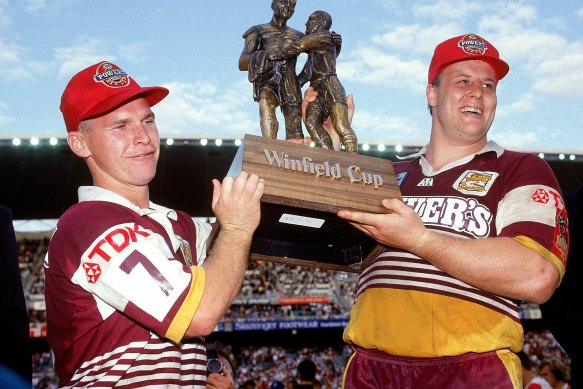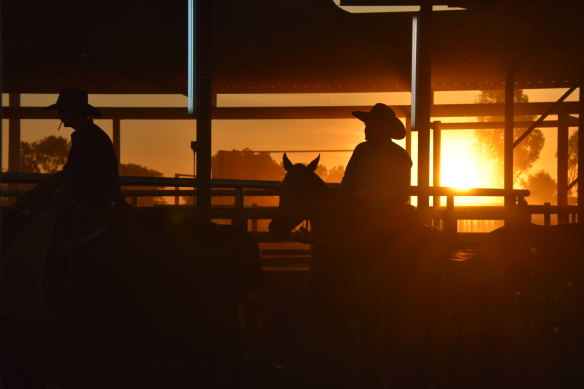This was published 3 years ago
Thirty years since the daylight saving poll, a new generation deserves its say
Thirty years ago on Tuesday, Salt-N-Pepa’s Let’s Talk About Sex had just ended a four-week reign at the top of the Australian charts.
Then-prime minister Paul Keating had just started his campaign to remove the Union Jack from the Australia flag and was just three days away from being labelled the “Lizard of Oz” for scandalously (gasp!) touching the Queen.

The Brisbane Broncos won their first premiership the year Queensland voted to get rid of daylight saving.Credit: Archive
Presidential hopeful Bill Clinton’s Democratic primary campaign was gathering steam, the Brisbane Broncos were about to start their first premiership-winning season and Wayne’s World was introducing a whole new generation to Bohemian Rhapsody.
And Queenslanders voted to abolish daylight saving in the state.
A lot has changed in those three decades, not least of which the Broncos’ prospects come October.
What has not changed, however, is the annual hand-wringing around daylight saving, when Queensland’s neighbours to the south move their clocks forward an hour.
It has been so since the short-lived Summer Time Act, which introduced daylight saving to Queensland in 1990, was repealed after a February 22, 1992, referendum.
That’s 30 years ago on Tuesday.
“I have no doubt that, while the repeal of the Summer Time Act 1990 will see an end to daylight saving in Queensland, the debate on daylight saving – and the absence of it in Queensland – will continue,” then-premier Wayne Goss said in Parliament following the referendum.
How right he was.
It’s like clockwork (so to speak). The debate ignites every October, as Coolangatta’s neighbours in Tweed Heads suddenly find themselves an hour ahead of their Queensland cousins.
Many, including Daylight Saving 4 Queensland campaigner Nick Lloyd, think it is time to revisit the issue and he says a new referendum is the only way to do it.
“One thing about a referendum is that it puts the matter more easily to bed,” he said.
“So there is no room for any of them to bring it back up again for at least an entire generation.”
But not all Queenslanders agree. Some, like Mount Isa-based state MP Robbie Katter, are openly antagonistic to the idea.

The daylight saving debate in Queensland has een geographically divided, with the No vote strongest in the north and west and the south-east in favour.Credit: Lydia Lynch
In November, Mr Katter presented a petition to the Queensland Parliament in November opposing daylight savings, attracting 7750 signatures.
At the same time as Mr Katter’s petition was in the field, a pro-daylight saving petition attracted 18,507 signatures.
Attorney-General Shannon Fentiman responded to both petitions on the same day, December 17, last year.
In both letters, Ms Fentiman notes the introduction of daylight saving is “not currently under consideration” by the government.
“The government believes there are other priorities facing Queenslanders that require attention, including delivering initiatives in response to the impacts of the COVID-19 pandemic, as outlined in our Economic Recovery Plan,” she said.
Interestingly, however, Ms Fentiman has some additional comments in her response to the pro-daylight saving petition.
“I note the petitioners’ views: that daylight saving could assist in supporting Queensland’s economic recovery from COVID-19 including through business efficiencies and increased tourism and retail opportunities; and that daylight saving should be introduced in Queensland or, at the very least, in the south-east of the state,” she said.
Read into that what you will.
Mr Lloyd, for one, said the state government was missing a golden opportunity to lead.
“If Labor can lead against those who refuse to get vaccinated, then surely they can lead against the small minority who are not for any form of daylight saving,” he said.
Central to opposition from the north-west of the state is the impost a change in timezone would have in those hot regions that already have later sunsets. In Mr Katter’s petition, he notes Queensland’s geographic divide.
“Recent university research has claimed that [daylight saving time] is supported by 60 per cent of Queenslanders, and therefore it should be introduced immediately,” he said.
“However, this is underwhelming support when considering 73 per cent of Queenslanders live in the south-east corner, which is the only region in the state that typically desires longer days.”
To allay concerns from rural Queensland, Mr Lloyd suggested following the lead of New South Wales. There, the outback town of Broken Hill, not far from the South Australian border, operates on Central time.
Broken Hill citizens live on Adelaide time, rather than their own state capital of Sydney.
“It’s definitely a common compromise around the world and Western society,” Mr Lloyd said.
“There are about 14 or so dual-time states in the United States that adopt that sort of dual out arrangement.
“Florida is a classic example. It’s a tourism state and Pensacola, in the north-west corner of that state, are on a different time to the rest of their state.
“I understand Queensland politicians are highly parochial about the state being split into two time zones, but that said, they can just allow western Queensland to officially start and finish work and school half an hour later.”
But any decision to reintroduce daylight saving, Mr Katter said in his petition, would “further the cultural, economic and political divide that already exists between the south-east corner and the rest of the state”.
Further comment was sought from Mr Katter.
Whichever side of the fence one lands, it is clear a referendum held 30 years ago holds little weight now.
On the day of the 1992 referendum, there were 1,835,727 Queenslanders on the electoral role. As of the 2020 state election, that number had increased by 84 per cent, to 3,377,476.
No Queenslander under the age of 48 has had their say. These changing demographics, Mr Lloyd said, means it is time to go to the polls again.
“The Queensland economy needs an economic recovery as soon as possible after all we’ve been through with COVID,” he said.
“There’s tourism benefits. There’s health benefits. There’s economic benefits.”
Whether one is for or against daylight saving, it is clear the poll of 1992 cannot be considered an accurate reflection of Queensland’s preferences.
If nothing else, another poll would end the tired, annual debate.
For a few decades, at least.